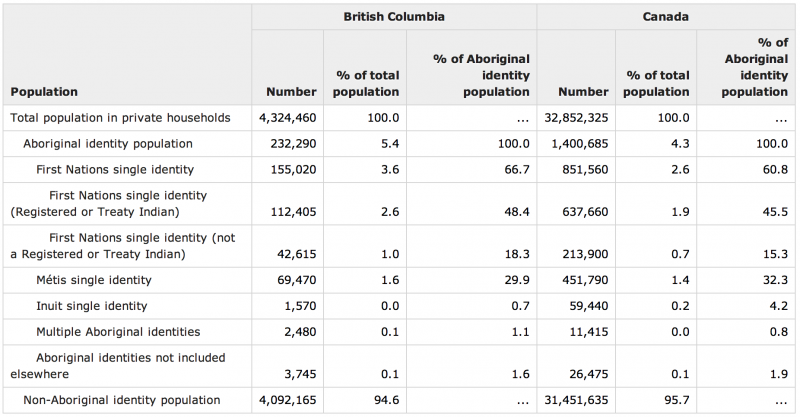2. Aboriginal Issues in British Columbia
Introduction
Archeological evidence shows that humans have inhabited the area now known as British Columbia (BC) for at least 10,000 to 12,000 years. The two most widely recognized routes for the migration of humans into the region are along the coast and through an interior ice-free corridor.
The term Aboriginal refers to the ancestors of these inhabitants and includes the distinct subgroups of Inuit, Métis and First Nations peoples.
Pre-contact Aboriginal communities were located throughout BC in three cultural regions identified as the northwest coast, southern Interior, and northern Interior. These three cultural regions had dramatically different ecosystems to which indigenous people adapted. The southern Interior was the most climatically dry, the northern Interior the coldest, and the northwest coast the wettest and richest in terms of animal and plant resources.
Although the pre-contact Aboriginal population may have numbered over 300,000, by 1881 European settlement had reduced Aboriginal population to an estimated 40,000. In fact, increasing European contact and settlement from the 19th century until present has had a major impact on every aspect of Aboriginal life.
The 2011 National Household Survey found that 232,290 people identified as Aboriginal in BC. This represents 16% of the total number of Aboriginal people in Canada (1,400,685) and 5.4% of the entire BC population. The number of people self identifying as Aboriginal has increased significantly since the early 1990s (1996 = 139,655; 2001 = 170,020; 2006 = 196,075; 2011 = 232,290) due to both increases in population and an increasing willingness of people (especially those over 35 and Métis) to identify as Aboriginal. Of the BC Aboriginal population, 66.7% identified as First Nations; 29.9% as Métis; and 3.4% as Inuit, multiple Aboriginal identities or Aboriginal identities not included elsewhere (see the table below). The median age of the Aboriginal population in 2011 was 28.9 years, much lower than the 42.2 years for the non-Aboriginal population in BC. Most of the Aboriginal population live off reserve, with only 44.2% of the 112,400 First Nations people with registered Indian status living on reserve.

While the majority of BC Aboriginals self identify as First Nations, the population is exceptionally diverse. For example, it includes 203 First Nations and over 30 spoken languages. According to the First Peoples Culture Council (FPCC), over 60% of all First Nations languages are spoken in BC. However, the FPCC estimates that the percentage of fluent speakers of native languages among Aboriginal populations declined to approximately 5.1% in 2010. The interactive First Nations Language Map of BC [1] shows the historical and contemporary spatial distribution of languages.
Despite recent positive trends of health, employment status and educational attainment indicators for BC’s Aboriginal communities, the same indicators reveal that off-reserve Aboriginal people continue to trail non-Aboriginals. As we will see below, the difference in these indicators is inextricably linked to BC’s colonial history of repressing Aboriginal access to traditional resources, Aboriginal political organization and Aboriginal cultural expression. The historic failure to negotiate treaties with First Nations has led to ongoing, contemporary efforts to negotiate a “new relationship” that respects Aboriginal rights and title as defined by the Royal Proclamation of 1763, the Constitution of Canada and legal jurisprudence.
First Contact
European contact with Aboriginal people in BC occurred later than it did in Eastern Canada. Initial contact occurred along coastal BC in 1774 when Spanish explorers sailed north from San Francisco and stopped at Nookta Sound, where they traded with the Mowachaht, part of the Nuu-chah-nulth First Nation. Four years later in 1778, British Captain James Cook stopped in Nootka Sound to repair his ship, staying for the better part of a month, where he initiated trade with the Mowachaht. The motivation for exploration in the region at the time was the fur trade in sea otter pelts, which were highly valued in Europe and many parts of Asia, as well as the establishment of colonial sovereignty over the land.
By the early 1800s, overland European explorers in search of beaver pelts, mostly commissioned by the Montreal-based North West Company, made contact with Aboriginal people living in eastern BC. The routes they travelled followed established Aboriginal trade routes, often called “grease trails,” after the oil produced from oolichan fish, and extending from the coast inland.
Conflict over land arose as contact between Aboriginal peoples and settlers increased. In 1858 the Fraser River gold rush drastically increased European and American migration and settlement to BC, with 25,000 to 30,000 people entering the area. The increase of settlers was matched by increased conflict over trespass and land use. Gold mining destroyed natural habitat, especially in freshwater marine environments, which in turn disturbed key food systems on a broader scale.
Attributions
- Table 3.1 NHS Focus on Geography Series – British Columbia from Statistics Canada (http://www12.statcan.gc.ca/nhs-enm/2011/as-sa/fogs-spg/Pages/FOG.cfm?lang=E&level=2&GeoCode=59) and used under non-commercial government license terms of use http://www.cic.gc.ca/english/notices.asp#copyright
- Interactive First Nations Language Map of BC http://maps.fphlcc.ca/ ↵

